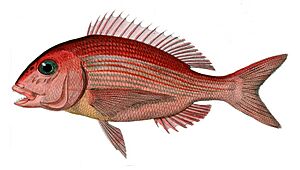Red porgy facts for kids
Quick facts for kids Red porgy |
|
|---|---|
 |
|
 |
|
| Conservation status | |
| Scientific classification | |
| Synonyms | |
|
The red porgy (Pagrus pagrus) is a cool fish that lives in the ocean. People also call it the common seabream or Couch's bream. It's a type of fish with fins that look like rays.
You can find red porgies in shallow waters on both sides of the Atlantic Ocean. They live near the western coast of Europe, in the Mediterranean Sea, and along the eastern coasts of North and South America, including the Caribbean Sea. This fish usually eats food found on or near the seabed. Many red porgies start their lives as females and later change into males.
Contents
About the Red Porgy
This fish was first described in 1758 by a Swedish scientist named Carl Linnaeus. He gave it the name Sparus pagrus. Later, scientists moved it to a different group called Pagrus.
Besides red porgy, people also call it the common seabream or just porgy. Along the Gulf Coast, some people call it the white snapper, even though it's not a true snapper fish. In the United Kingdom, it's known as Couch's seabream. This name honors Dr. Jonathan Couch, who first found this fish in British waters.
What Does a Red Porgy Look Like?
The red porgy has a body that is somewhat deep and shaped like an oval. It can grow up to about 75 centimeters (30 inches) long, but most are around half that size.
Its top fin, called the dorsal fin, has 11 to 13 sharp spines and 9 to 10 soft rays. The fin underneath, the anal fin, has 3 spines and 7 to 8 soft rays. This fish is a pretty silvery-pink color. It has darker spots on its neck and behind its front fins. The tail fin is dark pink with lighter tips, and its other fins are light pink.
Where Red Porgies Live
The red porgy lives in warm coastal waters on both sides of the Atlantic Ocean. On the eastern side, you can find them from southern Britain all the way to Western Sahara. This includes the Canary Islands, Madeira, and the Mediterranean Sea. They are also in the Sea of Marmara but not the Black Sea.
On the western side of the Atlantic, they live from the eastern United States down to Argentina. They are found in the Gulf of Mexico and the western part of the Caribbean Sea. Red porgies usually live at depths between 10 and 80 meters (33 to 262 feet). They can go as deep as 250 meters (820 feet). They prefer areas with rocks or soft sand on the seabed. Young red porgies often live in beds of seagrass or in calm lagoons.
Red Porgy Life and Habits
Red porgies are bottom-dwelling fish. This means they spend most of their time on or near the seabed. They mostly eat crustaceans like crabs and shrimp, molluscs like clams, and small fish.
Reproduction and Life Cycle
Most red porgies are born female. As they get older, many of them change sex and become males. This is called being a protogynous hermaphrodite. They become ready to have babies when they are two or three years old.
The sex change can happen at different sizes and ages. Some fish change when they are two years old, while others might wait until they are nine. Not all red porgies change sex. Some are born male and stay male. Others act as females for a while before changing. Some even stay female their whole lives, even when they are big. Scientists think that things like their social group or the environment might affect when they change sex.
Red Porgy Conservation Status
The red porgy is an important fish for both commercial fishing (where people catch them to sell) and recreational fishing (where people catch them for fun). This is especially true along the southeastern coast of the United States, in Argentina, and in the Mediterranean Sea. They are usually caught with a fishing rod and line.
The number of red porgies has gone down in some areas because too many have been caught. To help, some places have set rules about the smallest size of fish that can be caught. People are also trying to raise more red porgies in special farms, which is called aquaculture. This is happening a lot in the Mediterranean and is being thought about in North America.
Even though their numbers have dropped in some places, the red porgy is not in danger of disappearing completely. The International Union for Conservation of Nature says that its conservation status is "least concern". This means they are not currently at risk of extinction.
Images for kids




